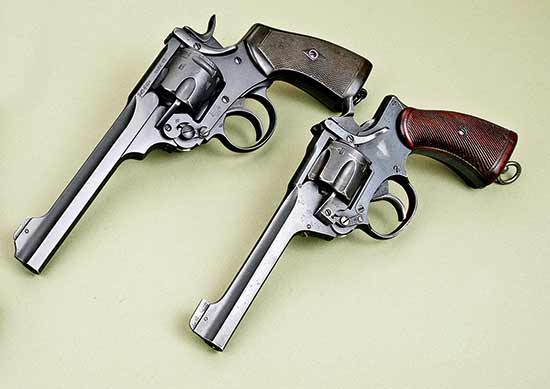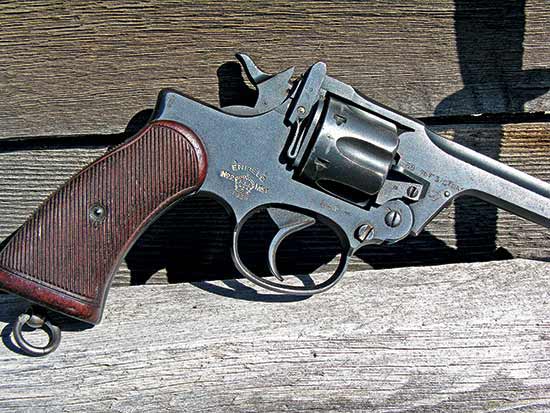Almost Right: The Enfield NO. 2 MK 1 .38
In regards to handguns, the British often don’t get things right. Well, they usually don’t get things right. Oh, heck, they almost never get things right. One example will suffice. They adopted the Webley Mk VI .455 in 1916. It’s a huge honker of a sixgun but chambered for a little quack of a cartridge. That’s a 260-grain bullet at 650 fps!
But one time with one handgun the Brits almost got things right. That’s the Enfield No. 2 Mk I .38. It’s a delightful little revolver with break-open function and a double-action trigger mechanism. A variant — the No2 Mk I* — is double action only because it was issued to tank crewmen who didn’t want hammer spurs hanging up in emergencies such as bailing out of their burning Sherman after tangling with a German Tiger.
The Enfield No. 2 Mk I in my collection weighs a mere 28 ounces with a 5″ barrel and checkered walnut grips. Its double-action trigger pull is one of the shortest I’ve ever encountered during 50+ years of shooting. Its single-action trigger is reasonable at five pounds. The grip’s backstrap is serrated, and the hammer and break-open lever are nicely checkered. The whole thing is finished dull blue. Interestingly, its barrel is oddly shaped: flat on the sides, rounded beneath and with a full-length rib on top.
The muzzle end of the rib ends in an integral ramp into which various heights of sight blades can be affixed for zeroing elevation. Rear sight is a large blade with square notch as part of the break-open lever. Those sights beat anything on American fighting handguns of the same era. And the era ran from adoption in 1932 to replacement by the FN Hi Power (P35) 9mm in 1957 although it continued to serve in British holsters into the early 1960’s.
Spitfire Gun?
Sometimes my impetuous nature gets me into trouble at gun shows when I quickly buy something catching my attention — without proper consideration. Buying this little .38 wasn’t one of those times. It was made by Enfield (some were made by Birmingham Small Arms) and dated 1936. It carries all the little British proof marks they customarily scratch up guns with and best of all, is stamped R.A.F. on its right side. In my mind then it just had to have ridden inside a Spitfire, circa 1940.
Why I say the British almost got my sixgun right is its little .38 cartridge. They named it the .380 Revolver Mk 1 but it’s nothing more than the .38 S&W introduced in Smith & Wesson’s Baby Russian circa 1875. First off, the Brits loaded it with 200-gr. lead-alloy bullets at a miserable 630 fps. This was a duplication of Winchester’s .38 S&W Super Police load from the early 19th century. Germany rightly squawked about Britain’s use of lead bullets in World War II so the load was changed to a 178-gr. FMJ (.380 Revolver Mk II) to make them happy. Winchester factory ammo for .38 S&W is still factory loaded with 145-gr. lead alloy roundnoses rated at a nominal speed of 685 fps. From my little Enfield they clocked at 667 fps.
Better yet, Starline makes .38 S&W brass and Lyman’s bullet mold #358430 is nominally for a 195-gr. roundnose. My 1-20 tin to lead alloy makes them drop right at 200 grains so it’s easy to duplicate the Brits’ initial .38/200 lead bullet load with a charge of 2.0 grains of Bullseye or Titegroup.
My Enfield must have been sighted for the .38/200 Mk I load because it hits to point of aim with the above handload. Once for fun I set a surplus US army helmet on a fence post and popped it with one of those 200-grain loads. The old steel pot wobbled, wasn’t dented and didn’t even fall off the post.
Shame the British couldn’t come up with a better cartridge for such a nice little handgun.








